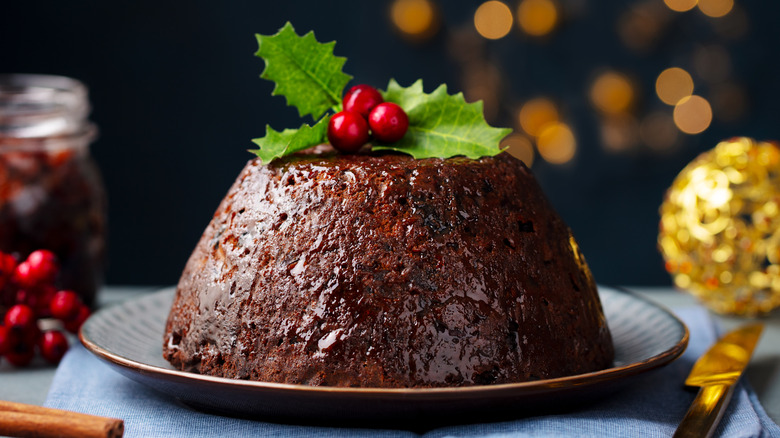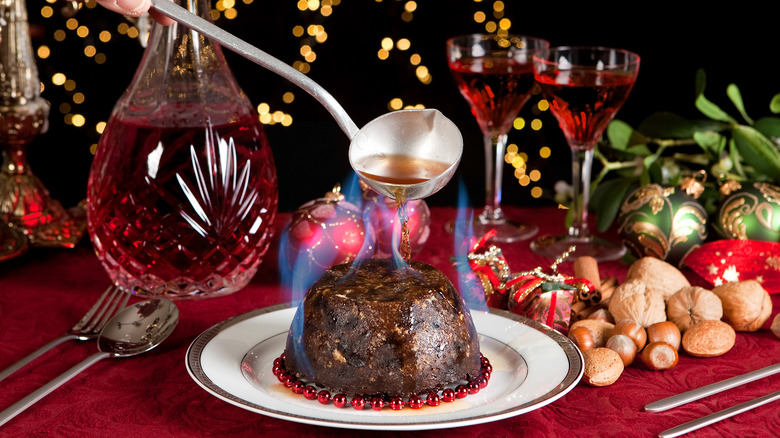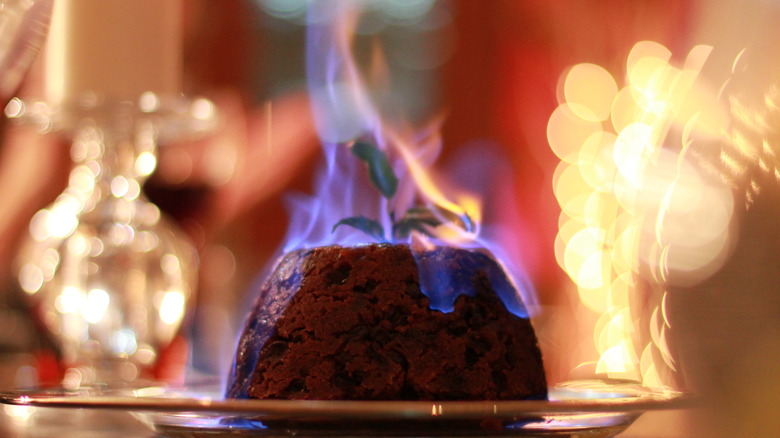Traditional Christmas Pudding Dates Back To 14th Century Britain
Christmas is a holiday abundant with traditions. Every country around the world has some unique customs, and sometimes these Christmas traditions are weird. Naturally, there's the evil Krampus in Austria (via the History Channel), who has fired the imagination of many in recent years. Then there's an Irish custom that Rural Mom shares in which a bottle of Guinness beer and a mince pie are left for Santa in lieu of cookies and milk. In Japan, it's convention to eat at KFC on Christmas (via CNN). Then, there's Christmas pudding.
According to The Conversation, Christmas pudding is a traditional part of the holiday in Britain. But those who imagine it to be similar to typical pudding would be mistaken. Instead of being a creamy custard-style dessert, Christmas pudding more closely resembles what is known as fruit cake, which is one of the standard Christmas cakes from around the world. Like fruit cake, Christmas pudding is baked with various sweet and candied fruits. Though, it wasn't always that way.
As it turns out, the first Christmas pudding probably looked, smelled, and tasted far different than its modern versions. According to the History Channel, it has roots buried in medieval sausages, and its early ingredients included grains, fruit, and spices.
Christmas pudding comes from a dish called frumenty
In the popular carol "We Wish You a Merry Christmas," there's a reference to figgy pudding. HuffPost claims that this is the same as Christmas pudding, which is also known as plum pudding and has been appearing in Britain for hundreds of years. One look at Michel Roux Jr.'s Christmas pudding recipe shows it's made with raisins, currants, sugar, almonds, carrots, cinnamon, cherries, and brandy. Usually a lot of brandy. But, in the past, it was wildly different.
The Guardian reports that there are essentially two predecessors to Christmas pudding. The first is early mince pies, which had meat, fruit, and alcohol. The other is a dish with the onomatopoetically delightful name frumenty, which The Conversation says comes from the 14th century. Frumenty was more of a slurry or porridge full of cracked wheat, nuts, and berries. It was ladled out as an appetizer but had a consistency more akin to regular pudding.
It seems that through mixing mince pies and frumenty, ultimately the Christmas pudding that Britons love — or at least continue to make — was born. Now, if the flavor could only be improved so that it didn't taste like it was 700 years old, it might be worthy of extra celebration.
Christmas pudding was almost banned (along with all the other holiday treats)
Whether or not you are a fan of Christmas pudding, the traditional dessert was almost eradicated from history. Like many things, Queen Victoria popularized the dish we recognize today. But before its royal upgrade, there was a time when certain groups of people, namely the Puritans, didn't want to see the dish anywhere near a Christmas celebration.
Around 1647, Christmas pudding was banned from holiday tables and festive gatherings. According to History, "yule logs, carol-singing and nativity scenes" were also banned by Puritanical ruler Oliver Cromwell, who thought that Christmas should be a time for quiet repentance and fasting instead of the indulgent celebration it had become. Luckily, this only lasted until 1660, when Cromwell was dethroned and Christmas pudding returned.
These days, catching a glimpse of a Christmas pudding on your holiday table is becoming increasingly less common – according to a 2018 Tesco survey that analyzed how British people are celebrating Christmas, only 58% of those aged 18-35 said they enjoyed Christmas pudding, as opposed to the 59% over the age of 55. This could be due to its unappetizing appearance or less favorable flavor. Even still, the survey found that around 40% of British people will serve the classic dish at their annual festivities.
People use to toss silver coins into Christmas pudding batter
If Christmas pudding is on the menu during your holiday season, check for coins before digging in. Back in the day, you could lose a tooth while biting into this classic British dessert if you were lucky enough to grab a slice with a Christmas coin inside. It was common for pudding preparation to be a family event: The Sunday before Christmas, aptly named "Stir Up Sunday," each member of British households would take turns stirring the pudding batter while making a wish. Not unlike wishing wells or fountains, families would toss Christmas coins, such as a sixpence or threepence, into the batter for lucky family members to enjoy.
This practice was meant to symbolize wealth, dating back to the 1300s when people uncovered things like jewelry and money inside their batter. Tossing money into a cake sounds like harmless fun until you consider just how dirty money gets. These days, people who still participate in this tradition opt for larger, more sentimental tokens that can be easily spotted in a slice of pudding without the risk of cracking a tooth.



